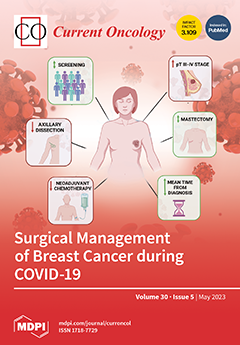Background: PSA density and an elevated PI-RADS score are among the strongest predictors of prostate cancer (PCa) in a fusion biopsy. Positive family history, hypertension, diabetes, and obesity have also been associated with the risk of developing PCa. We aim to identify predictors
[...] Read more.
Background: PSA density and an elevated PI-RADS score are among the strongest predictors of prostate cancer (PCa) in a fusion biopsy. Positive family history, hypertension, diabetes, and obesity have also been associated with the risk of developing PCa. We aim to identify predictors of the prostate cancer detection rate (CDR) in a series of patients undergoing a fusion biopsy. Methods: We retrospectively evaluated 736 consecutive patients who underwent an elastic fusion biopsy from 2020 to 2022. Targeted biopsies (2–4 cores per MRI target) were followed by systematic mapping (10–12 cores). Clinically significant PCa (csPCa) was defined as ISUP score ≥ 2. Uni- and multi-variable logistic regression analyses were performed to identify predictors of CDR among age, body mass index (BMI), hypertension, diabetes, positive family history, PSA, a positive digital rectal examination (DRE), PSA density ≥ 0.15, previous negative biopsy status, PI-RADS score, and size of MRI lesion. Results: The median patients’ age was 71 years, and median PSA was 6.6 ng/mL. A total of 20% of patients had a positive digital rectal examination. Suspicious lesions in mpMRI were scored as 3, 4, and 5 in 14.9%, 55.0%, and 17.5% of cases, respectively. The CDR was 63.2% for all cancers and 58.7% for csPCa. Only age (OR 1.04,
p < 0.001), a positive DRE (OR 1.75,
p = 0.04), PSA density (OR 2.68,
p < 0.001), and elevated PI-RADS score (OR 4.02,
p = 0.003) were significant predictors of the CDR in the multivariable analysis for overall PCa. The same associations were found for csPCa. The size of an MRI lesion was associated with the CDR only in uni-variable analysis (OR 1.07,
p < 0.001). BMI, hypertension, diabetes, and a positive family history were not predictors of PCa. Conclusions: In a series of patients selected for a fusion biopsy, positive family history, hypertension, diabetes, or BMI are not predictors of PCa detection. PSA-density and PI-RADS score are confirmed to be strong predictors of the CDR.
Full article






